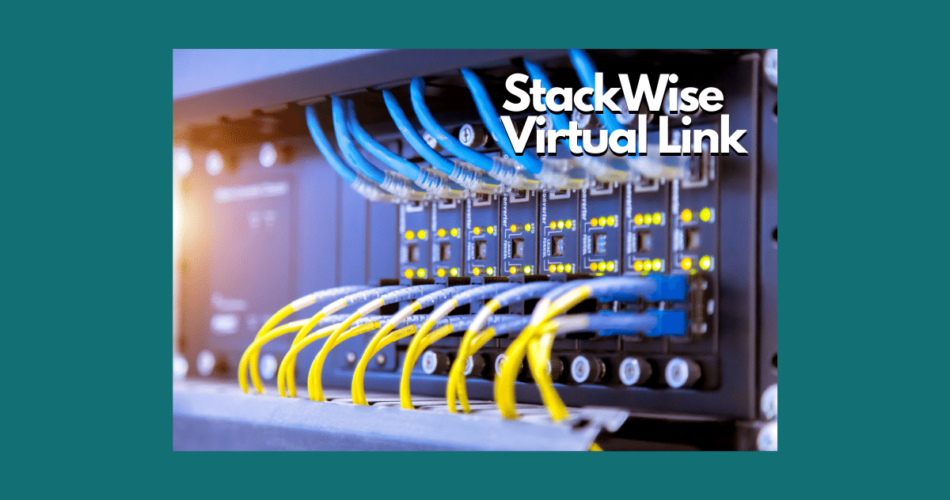Cisco Catalyst 9000 infrastructure StackWise Virtual Link consolidates two physical switches into a single logical entity. The two switches function as a single entity; their configuration and forwarding state are identical. This technology improves all aspects of network design, including high availability, scalability, management, and maintenance.
Stacks are useful for rapidly expanding a network’s capacity, as the name suggests. This set of switches functions as if it were a single switch but has the total port capacity of all switches in the set. When a stack functions as a single switch, rather than having separate IP addresses for each unit, remote administration is performed through a single address.
Benefits
These things are good about stackable switches:
- Simplified network administration: Network management is easier because a stackable switch can work alone or “stacked” with other units. In either case, the network administrator only has to deal with one management interface. This makes it easier to set up and run the network.
- Scalability: A small network can be built around a single stackable unit, and if and when more units are needed, the network can grow by adding them. This doesn’t make it harder to manage the network.
- Deployment flexibility: Switches that can be stacked can work with other switches that can be stacked or on their own. Units can be put together as a stack at a single site one day and then run as separate switches at other sites the next.
- Resilient connections: In some vendor architectures, active connections can be spread across multiple units. This way, if one unit in a stack is removed or stops working, data will still flow through the other units that are still working.
- Backplane improvement: When several switches are stacked on top of each other, the backplane of all the switches in the stack is also improved.
Drawbacks
Stackable switches aren’t as good as modular chassis switches because:
- A modular chassis may be cheaper for places that need a lot of ports. Each unit in a stack of stackable switching has its case and at least one power supply. With modular switching, there is only one box and one set of power supplies.
- Some stackable architectures don’t have the same high-resiliency/high-redundancy features as high-end modular switches.
- When sending stacked data between switches, it takes more time. Some stacking protocols add more headers to frames, which makes the overhead even higher.

Cisco Catalyst 9000 Platform StackWise Virtual Configuration
In this article, I’ll demonstrate how to set up StackWise Virtual on a Catalyst C9407R pair of switches, including how to decide on a port configuration for the StackWise Virtual Link (SVL).
Cisco StackWise Virtual simplifies network management by merging two physical switches into a single logical virtual switch. Without using Spanning Tree as a failover protocol, a single virtual switch can establish port channels to multiple physical leaf/spoke switches.
SW-1 Configuration
! SW-01#switch priority 15 ! SW-01#config t SW-01(config)#stackwise-virtual ! SW-01(config-stackwise-virtual)# domain 140 SW-01(config-stackwise-virtual)# exit ! SW-01(config)#interface range Ten3/0/7, Ten3/0/8 SW-01(config-if-range)#stackwise-virtual link 1 SW-01(config-if-range)#exit ! SW-01(config)#interface range Ten3/0/5, Ten3/0/6 SW-01(config-if-range)#stackwise-virtual dual-active-detection SW-01(config-if-range)#exit SW-01(config)#exit SW-01# wr mem SW-01# reload
SW-2 Configuration
! SW-02#config t SW-02(config)#stackwise-virtual ! SW-02(config-stackwise-virtual)# domain 140 SW-02(config-stackwise-virtual)# exit ! SW-02(config)#interface range Ten3/0/7, Ten3/0/8 SW-02(config-if-range)#stackwise-virtual link 1 SW-02(config-if-range)#exit ! SW-02(config)#interface range Ten3/0/5, Ten3/0/6 SW-02(config-if-range)#stackwise-virtual dual-active-detection SW-02(config-if-range)#exit SW-02(config)#exit SW-02# wr mem SW-02# reload

Verification Commands
Here are some commands you can use to double-check your work after the switches have reloaded:
show stackwise-virtual
SW-01#show stackwise-virtual
Stackwise Virtual Configuration:
--------------------------------
Stackwise Virtual : Enabled
Domain Number : 140
Switch Stackwise Virtual Link Ports
------ ---------------------- ------
1 1 TenGigabitEthernet1/3/0/7
TenGigabitEthernet1/3/0/8
2 1 TenGigabitEthernet2/3/0/7
TenGigabitEthernet2/3/0/8
show stackwise-virtual link
SW-01#show stackwise-virtual link
Stackwise Virtual Link(SVL) Information:
----------------------------------------
Flags:
------
Link Status
-----------
U-Up D-Down
Protocol Status
---------------
S-Suspended P-Pending E-Error T-Timeout R-Ready
-----------------------------------------------
Switch SVL Ports Link-Status Protocol-Status
------ --- ----- ----------- ---------------
1 1 TenGigabitEthernet1/3/0/7 U R
TenGigabitEthernet1/3/0/8 U R
2 1 TenGigabitEthernet2/3/0/7 U R
TenGigabitEthernet2/3/0/8 U R
show stackwise-virtual dual-active-detection
SW-01#show stackwise-virtual dual-active-detection
In dual-active recovery mode: No
Recovery Reload: Enabled
Dual-Active-Detection Configuration:
-------------------------------------
Switch Dad port Status
------ ------------ ---------
1 TenGigabitEthernet1/3/0/5 up
TenGigabitEthernet1/3/0/6 up
2 TenGigabitEthernet2/3/0/5 up
TenGigabitEthernet2/3/0/6 up
Show redundancy
SW-01#show redundancy
Redundant System Information :
------------------------------
Available system uptime = 1 week, 5 days, 17 hours, 43 minutes
Switchovers system experienced = 0
Standby failures = 0
Last switchover reason = none
Hardware Mode = Duplex
Configured Redundancy Mode = sso
Operating Redundancy Mode = sso
Maintenance Mode = Disabled
Communications = Up
Current Processor Information :
-------------------------------
Active Location = Switch 1
Current Software state = ACTIVE
Uptime in current state = 1 week, 5 days, 17 hours, 43 minutes
Image Version = Cisco IOS Software [Gibraltar], Catalyst L3 Switch Software (CAT9K_IOSXE), Version 16.12.02, RELEASE SOFTWARE (fc2)
Technical Support: http://www.cisco.com/techsupport
Copyright (c) 1986-2019 by Cisco Systems, Inc.
Compiled Tue 19-Nov-19 10:04 by mcpre
BOOT = bootflash:packages.conf;
Configuration register = 0x102
Peer Processor Information :
----------------------------
Standby Location = Switch 2
Current Software state = STANDBY HOT
Uptime in current state = 1 week, 5 days, 17 hours, 40 minutes
Image Version = Cisco IOS Software [Gibraltar], Catalyst L3 Switch Software (CAT9K_IOSXE), Version 16.12.02, RELEASE SOFTWARE (fc2)
Technical Support: http://www.cisco.com/techsupport
Copyright (c) 1986-2019 by Cisco Systems, Inc.
Compiled Tue 19-Nov-19 10:04 by mcpre
BOOT = bootflash:packages.conf;
CONFIG_FILE =
Configuration register = 0x102
show switch
SW-01#show switch
Switch/Stack Mac Address : 3c51.0e7e.7744 - Local Mac Address
Mac persistency wait time: Indefinite
H/W Current
Switch# Role Mac Address Priority Version State
-------------------------------------------------------------------------------------
*1 Active 3c51.0e7e.7744 15 V02 Ready
2 Standby 3c51.0e7e.7798 1 V02 Ready
show stackwise-virtual bandwidth
SW-01#show stackwise-virtual bandwidth Switch Bandwidth ------ --------- 1 20G 2 20G
show stackwise-virtual neighbors
SW-01#show stackwise-virtual neighbors
Stackwise Virtual Link(SVL) Neighbors Information:
--------------------------------------------------
Switch SVL Local Port Remote Port
------ --- ---------- -----------
1 1 TenGigabitEthernet1/3/0/7 TenGigabitEthernet2/3/0/7
TenGigabitEthernet1/3/0/8 TenGigabitEthernet2/3/0/8
2 1 TenGigabitEthernet2/3/0/7 TenGigabitEthernet1/3/0/7
TenGigabitEthernet2/3/0/8 TenGigabitEthernet1/3/0/8
What does DAD link do?
Dual-Active Detection (DAD)
If the standby switch detects a total loss of the SVL, it assumes the active switch has failed and assumes control as the active switch. If the original Cisco StackWise Virtual active switch remains operational, both switches will be Cisco StackWise Virtual active switches. This is known as a dual-active scenario. Because both switches use the same IP addresses, SSH keys, and STP bridge IDs, this scenario may have an adverse effect on network stability. Cisco StackWise Virtual detects and responds to a dual-active scenario. The DAD link is a dedicated link that is used to mitigate this.
The Cisco StackWise Virtual standby switch cannot determine the state of the Cisco StackWise Virtual active switch if an SVL fails. The Cisco StackWise Virtual standby switch assumes that the Cisco StackWise Virtual active switch has failed and initiates switchover to take over the Cisco StackWise Virtual active role. The original Cisco StackWise Virtual Active switch enters recovery mode, which disables all interfaces except the SVL and management interfaces.
Please look at this Cisco article page for more reading.




